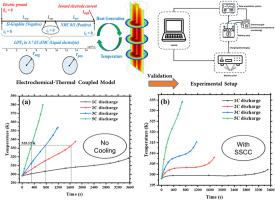高放电率锂离子电池组蛇形液体冷却通道的电化学-热耦合建模
IF 5
2区 工程技术
Q1 ENGINEERING, MECHANICAL
International Journal of Thermal Sciences
Pub Date : 2025-09-24
DOI:10.1016/j.ijthermalsci.2025.110299
引用次数: 0
摘要
电动汽车(ev)中锂离子电池(lib)在高倍率下的安全性和性能取决于有效可靠的热管理。锂离子电池中的温度依赖电化学反应导致高能量密度电池的热生成不均匀,这给电池热管理系统(BTMS)的设计和优化工作参数带来了挑战。本研究开发并优化了一种新型蛇形液体冷却通道(SSCC),用于包含5ah, 21700个圆柱形锂电池的电池组。考虑接触角为60°,环境温度为298 K,在不同冷却剂速度、液体通道高度和排放速率下进行了数值研究。结果表明,在没有冷却的情况下,电池组在5C放电速率下达到380 K的临界温度,存在安全隐患。然而,基于sscc的液冷BTMS有效地将最高温度降低到334 K。最佳配置是50 mm通道高度和0.3 m/s冷却剂速度,保持整个电池组的温度均匀性在3k以内。此外,泵送功率和压降的增加比冷却剂速度对热性能的影响更显著。与底部冷却板和组合冷却装置的对比分析突出了所提出的设计在快速排放情况下的优越性能。SSCC在降低压降的同时,实现了更好的降温和均匀性。该研究为远程电动汽车开发先进的BTMS提供了有价值的见解,这些BTMS利用高功率锂电池,确保了安全性、效率和延长了电池寿命。本文章由计算机程序翻译,如有差异,请以英文原文为准。

Electrochemical-thermal coupled modeling of a serpentine-shaped liquid cooling channel for lithium-ion battery packs with high discharge rates
The safety and performance of lithium-ion batteries (LIBs) in electric vehicles (EVs) operating at high C-rates depend on effective and reliable thermal management. The temperature-dependent electrochemical reactions in LIBs lead to uneven heat generation in high-energy-density cells, making it challenging to design and optimize the operating parameters of a battery thermal management system (BTMS). This study develops and optimizes a novel serpentine-shaped liquid cooling channel (SSCC) for a battery pack comprising 5 Ah, 21700 cylindrical LIBs. A numerical investigation is conducted under varying coolant velocities, liquid channel heights, and discharge rates, considering a contact angle of 60° and an ambient temperature of 298 K. Results depict that without cooling, the battery pack reaches a critical temperature of 380 K at a 5C discharge rate, posing safety risks. However, the SSCC-based liquid cooling BTMS effectively reduces the maximum temperature to 334 K. The optimal configuration is achieved with 50 mm channel height and 0.3 m/s coolant velocity, maintaining temperature uniformity within 3 K across the battery pack. Also, increased pumping power and pressure drop influence thermal performance more significantly than coolant velocity. Comparative analyses with bottom cooling plates and combined cooling arrangements highlight the superior performance of the proposed design in fast discharge scenarios. The SSCC achieves better temperature reduction and uniformity while minimizing pressure drop. This study provides valuable insights into developing advanced BTMS for long-range EVs utilizing high-power LIBs, ensuring safety, efficiency, and extended battery lifespan.
求助全文
通过发布文献求助,成功后即可免费获取论文全文。
去求助
来源期刊

International Journal of Thermal Sciences
工程技术-工程:机械
CiteScore
8.10
自引率
11.10%
发文量
531
审稿时长
55 days
期刊介绍:
The International Journal of Thermal Sciences is a journal devoted to the publication of fundamental studies on the physics of transfer processes in general, with an emphasis on thermal aspects and also applied research on various processes, energy systems and the environment. Articles are published in English and French, and are subject to peer review.
The fundamental subjects considered within the scope of the journal are:
* Heat and relevant mass transfer at all scales (nano, micro and macro) and in all types of material (heterogeneous, composites, biological,...) and fluid flow
* Forced, natural or mixed convection in reactive or non-reactive media
* Single or multi–phase fluid flow with or without phase change
* Near–and far–field radiative heat transfer
* Combined modes of heat transfer in complex systems (for example, plasmas, biological, geological,...)
* Multiscale modelling
The applied research topics include:
* Heat exchangers, heat pipes, cooling processes
* Transport phenomena taking place in industrial processes (chemical, food and agricultural, metallurgical, space and aeronautical, automobile industries)
* Nano–and micro–technology for energy, space, biosystems and devices
* Heat transport analysis in advanced systems
* Impact of energy–related processes on environment, and emerging energy systems
The study of thermophysical properties of materials and fluids, thermal measurement techniques, inverse methods, and the developments of experimental methods are within the scope of the International Journal of Thermal Sciences which also covers the modelling, and numerical methods applied to thermal transfer.
 求助内容:
求助内容: 应助结果提醒方式:
应助结果提醒方式:


